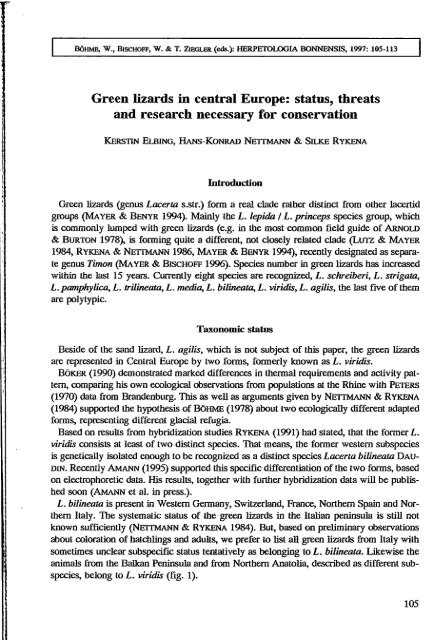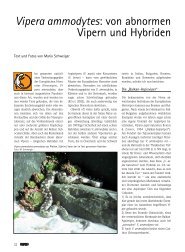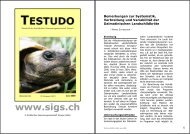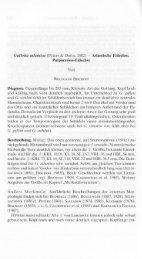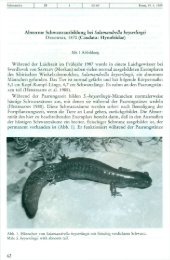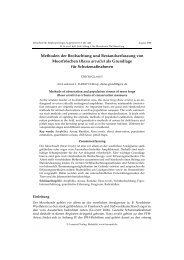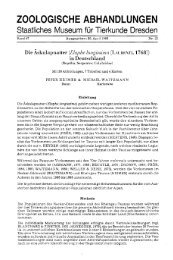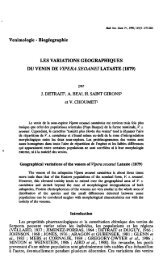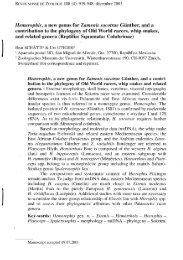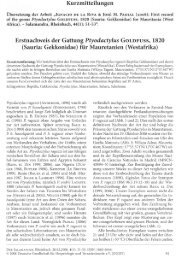Green lizards in central Europe: status, threats and ... - VipersGarden
Green lizards in central Europe: status, threats and ... - VipersGarden
Green lizards in central Europe: status, threats and ... - VipersGarden
You also want an ePaper? Increase the reach of your titles
YUMPU automatically turns print PDFs into web optimized ePapers that Google loves.
BOHMB, W., BISCHOFF, W. & T. ZlEGLER (eds.): HERPETOLOGIA BONNENSIS, 1997: 105-113<br />
<strong>Green</strong> <strong>lizards</strong> <strong>in</strong> <strong>central</strong> <strong>Europe</strong>: <strong>status</strong>, <strong>threats</strong><br />
<strong>and</strong> research necessary for conservation<br />
KERSTIN ELBING, HANS-KONRAD NETTMANN & SIIJCE RYKENA<br />
Introduction<br />
<strong>Green</strong> <strong>lizards</strong> (genus Lacerta s.str.) form a real clade rather dist<strong>in</strong>ct from other lacertid<br />
groups (MAYER & BENYR 1994). Ma<strong>in</strong>ly the L. lepida IL. pr<strong>in</strong>ceps species group, which<br />
is commonly lumped with green <strong>lizards</strong> (e.g. <strong>in</strong> the most common field guide of ARNOLD<br />
& BURTON 1978), is form<strong>in</strong>g quite a different, not closely related clade (Lurz & MAYER<br />
1984, RYKENA & NETTMANN 1986, MAYER & BENYR 1994), recently designated as separate<br />
genus Timon (MAYER & BISCHOFF 1996). Species number <strong>in</strong> green <strong>lizards</strong> has <strong>in</strong>creased<br />
with<strong>in</strong> the last 15 years. Currently eight species are recognized, L. schreiberi, L. strigata,<br />
L. pamphylica, L. tril<strong>in</strong>eata, L. media, L. bil<strong>in</strong>eata, L. viridis, L. agilis, the last five of them<br />
are polytypic.<br />
Taxonomic <strong>status</strong><br />
Beside of the s<strong>and</strong> lizard, L. agilis, which is not subject of this paper, the green <strong>lizards</strong><br />
are represented <strong>in</strong> Central <strong>Europe</strong> by two forms, formerly known as L. viridis.<br />
BOKER (1990) demonstrated marked differences <strong>in</strong> thermal requirements <strong>and</strong> activity pattern,<br />
compar<strong>in</strong>g his own ecological observations from populations at the Rh<strong>in</strong>e with PETERS<br />
(1970) data from Br<strong>and</strong>enburg. This as well as arguments given by NETTMANN & RYKENA<br />
(1984) supported the hypothesis of B6HME (1978) about two ecologically different adapted<br />
forms, represent<strong>in</strong>g different glacial refugia.<br />
Based on results from hybridization studies RYKENA (1991) had stated, that the former I.<br />
viridis consists at least of two dist<strong>in</strong>ct species. That means, the former western subspecies<br />
is genetically isolated enough to be recognized as a dist<strong>in</strong>ct species Lacerta bil<strong>in</strong>eata DAU-<br />
DIN. Recently AMANN (1995) supported this specific differentiation of the two forms, based<br />
on electrophoretic data. His results, together with further hybridization data will be published<br />
soon (AMANN et al. <strong>in</strong> press.).<br />
L. bil<strong>in</strong>eata is present <strong>in</strong> Western Germany, Switzerl<strong>and</strong>, France, Northern Spa<strong>in</strong> <strong>and</strong> Northern<br />
Italy. The systematic <strong>status</strong> of the green <strong>lizards</strong> <strong>in</strong> the Italian pen<strong>in</strong>sula is still not<br />
known sufficiently (NETTMANN & RYKENA 1984). But, based on prelim<strong>in</strong>ary observations<br />
about coloration of hatchl<strong>in</strong>gs <strong>and</strong> adults, we prefer to list all green <strong>lizards</strong> from Italy with<br />
sometimes unclear subspecific <strong>status</strong> tentatively as belong<strong>in</strong>g to L. bil<strong>in</strong>eata. Likewise the<br />
animals from the Balkan Pen<strong>in</strong>sula <strong>and</strong> from Northern Anatolia, described as different subspecies,<br />
belong to L. viridis (fig. 1).<br />
105
Fig. 1. Distribution of Lacerta bil<strong>in</strong>eata <strong>and</strong> Lacerta viridis.
The boundary between the two species, presumably <strong>in</strong> Slovenia <strong>and</strong> Croatia, hasn't been<br />
studied yet. The ma<strong>in</strong> problem is, to dist<strong>in</strong>guish the two species <strong>in</strong> the field, because the <strong>in</strong>traspecific<br />
variation <strong>in</strong> pholidosis characters as well as <strong>in</strong> colour pattern is greater than the<br />
<strong>in</strong>terspecific variation. Characters like prom<strong>in</strong>ent white stripes, which are often taken as typical<br />
<strong>in</strong> green lizard females from western <strong>Europe</strong>, occur <strong>in</strong> both species, although perhaps<br />
<strong>in</strong> different frequencies. Up to now only the hatchl<strong>in</strong>gs of the two species can be dist<strong>in</strong>guished<br />
easily by coloration characters. In both species the hatchl<strong>in</strong>gs are dorsally greyish<br />
brown to bronze, sometimes with more or less prom<strong>in</strong>ent light l<strong>in</strong>es <strong>and</strong> also light spots on<br />
the flanks. But the head sides <strong>and</strong> the throat is only whitish <strong>in</strong> L. viridis hatchl<strong>in</strong>gs while<br />
L. bil<strong>in</strong>eata hatchl<strong>in</strong>gs exhibit a characteristic green colour at these head regions (RYKENA<br />
1991, NETTMANN 1995, RYKENA et al. 1996 a, b).<br />
This taxonomic situation requires the new name Lacerta bil<strong>in</strong>eata <strong>in</strong> the species list of<br />
Great Brita<strong>in</strong>, France, Spa<strong>in</strong>, Switzerl<strong>and</strong>, Italy, Monaco <strong>and</strong> San Mar<strong>in</strong>o, while <strong>in</strong> Germany<br />
<strong>and</strong> perhaps Croatia <strong>and</strong> Slovenia both species exist. In all other countries no changes <strong>in</strong> the<br />
lists are necessary.<br />
Distribution <strong>in</strong> Central <strong>Europe</strong><br />
In most parts of <strong>central</strong> <strong>Europe</strong>, (roughly def<strong>in</strong>ed as the area between 6° <strong>and</strong> 27° east of<br />
<strong>Green</strong>wich <strong>and</strong> between 46° <strong>and</strong> 58° northern latitude) only isolated populations of either<br />
species occur <strong>in</strong> climatically favourable regions. The south-eastern part of the def<strong>in</strong>ed square,<br />
which belongs to the cont<strong>in</strong>uous distribution area of L. viridis, is neglected <strong>in</strong> this paper<br />
as well as the southern marg<strong>in</strong>, where L. bil<strong>in</strong>eata exists more or less cont<strong>in</strong>uously.<br />
L. bil<strong>in</strong>eata exists <strong>in</strong> the valleys of Rh<strong>in</strong>e, Mosel <strong>and</strong> Nahe. In the middle Rh<strong>in</strong>e region<br />
as well as <strong>in</strong> the valleys of Mosel <strong>and</strong> Nahe several viable populations are known, form<strong>in</strong>g<br />
a dist<strong>in</strong>ct distribution area (NiEHUis & SOUND 1996). In the upper Rh<strong>in</strong>e region only one<br />
or two isolated populations <strong>in</strong> the "Pfalz" <strong>and</strong> the populations <strong>in</strong> the "Kaiserstuhl" were<br />
known until recently <strong>in</strong> the French part of the valley <strong>in</strong> the Elsass several populations were<br />
found (GOOSE & CASTANET 1989), thus confirm<strong>in</strong>g the proposed immigration through the<br />
valleys of Rhone, Saone <strong>and</strong> Doubs. The Rhone valley region <strong>in</strong> Switzerl<strong>and</strong> as well as the<br />
southern side of the Alps belong to the cont<strong>in</strong>uous distribution area of L. bil<strong>in</strong>eata <strong>and</strong> are<br />
not discussed here.<br />
The distribution area of L. viridis reaches Central <strong>Europe</strong> along the Danube valley up to<br />
Passau. Isolated populations exist <strong>in</strong> Bohemia <strong>and</strong> <strong>in</strong> Br<strong>and</strong>enburg, while south Moravia <strong>and</strong><br />
Slovakia as well as Hungary, Romania <strong>and</strong> Croatia belong to the cont<strong>in</strong>uous distribution<br />
area. From Pol<strong>and</strong> only one observation was reported <strong>in</strong> the last 50 years (BiELAWSKi &<br />
RAMIK 1972). This population from south Silesia is presumably ext<strong>in</strong>ct (MA^LAK 1995). It<br />
was situated just <strong>in</strong> the region, where an migration from Moravia to the northern lowl<strong>and</strong>s<br />
was suggested by PETERS (1970), although no old observations from Silesia have been confirmed<br />
before. From northern Pol<strong>and</strong> no recent records exist. CORBETT (1989) mentioned<br />
some few rema<strong>in</strong><strong>in</strong>g populations <strong>in</strong> Pol<strong>and</strong> <strong>in</strong> the 1960s, which was an optimistic <strong>in</strong>terpretation<br />
of PETERS (1970) review. Old records exist from South Pomerania <strong>and</strong> from the Wistula<br />
valley around Torun (Thorn).<br />
107
Habitat types<br />
Typical habitats of L. bil<strong>in</strong>eata are v<strong>in</strong>eyards <strong>and</strong> other old <strong>and</strong> extensive agricultural<br />
areas at south exposed slopes of river valleys, often <strong>in</strong> connection with railroads, roads, or<br />
rema<strong>in</strong>s of such structures. Real xeric places are not used while rather moist places with<br />
dense vegetation must be present <strong>in</strong> the habitat (B6KER 1990). Similar habitat types are recorded<br />
from the upper Rh<strong>in</strong>e region.<br />
The!,, viridis habitats <strong>in</strong> Bavaria, Upper <strong>and</strong> Lower Austria as well as <strong>in</strong> Bohemia are also<br />
south exposed slopes of river valleys. In the presumed natural forests at these slopes patches<br />
of open l<strong>and</strong>scape has been created formerly either by man's activities <strong>in</strong> grow<strong>in</strong>g w<strong>in</strong>e<br />
or fruit trees <strong>and</strong> graz<strong>in</strong>g sheep or cattle, or by erosion caused by the rivers. Both factors<br />
are no longer very effective (NETTMANN 1996). Open habitats at the river banks, which are<br />
still important parts of the habitats at smaller rivers <strong>in</strong> Bohemia (STRODICKE 1995), are at<br />
the Danube normally isolated from the slopes by roads with much traffic, prevent<strong>in</strong>g migration<br />
from slopes to the banks. Thus the former habitat form<strong>in</strong>g dynamics, either natural or<br />
cultural, are lost almost irreversibly <strong>and</strong> has to be replaced by management measures<br />
(NETTMANN 1996).<br />
In Br<strong>and</strong>enburg a similar type of habitat, meadows, fruit gardens <strong>and</strong> roadsides near villages<br />
was recorded from the Oder valley, but those populations near Oderberg, at the northernmost<br />
well documented po<strong>in</strong>t of the species, have gone ext<strong>in</strong>ct <strong>in</strong> the early fifties (PE-<br />
TERS 1970). From the large xerotherm slopes at the Oder valley with a steppe vegetation<br />
with many pontic elements no records of L. viridis exist.<br />
The typical habitat type of L. viridis <strong>in</strong> Br<strong>and</strong>enburg, where the species has survived, is,<br />
accord<strong>in</strong>g to PETERS (1970) <strong>and</strong> PAEPKE (1970) a roadside or railroadside <strong>in</strong> large p<strong>in</strong>e forest<br />
on poor s<strong>and</strong>y soil. Own observations (ELBING 1996) <strong>in</strong>dicate, that also forest sites mixed<br />
with heath, <strong>and</strong> other patches of open l<strong>and</strong>scape <strong>in</strong> large forest regions are suitable habitats.<br />
Thus the amount of potential habitats <strong>in</strong> Br<strong>and</strong>enburg <strong>and</strong> also <strong>in</strong> adjacent regions is<br />
much larger than expected before, tak<strong>in</strong>g <strong>in</strong> account the large military tra<strong>in</strong><strong>in</strong>g areas of the<br />
former soviet troops.<br />
Status, <strong>threats</strong> <strong>and</strong> necessary research<br />
L. bil<strong>in</strong>eata <strong>in</strong> the Rh<strong>in</strong>e river system<br />
In the middle Rh<strong>in</strong>e region <strong>in</strong>tensive mapp<strong>in</strong>g of L. bil<strong>in</strong>eata habitats <strong>and</strong> protect<strong>in</strong>g measures<br />
were undertaken with<strong>in</strong> the last 10 years. From these it has been stated, that despite<br />
of the losses <strong>in</strong> habitats <strong>and</strong> populations <strong>in</strong> the last 100 years, the present situation is rather<br />
stable <strong>and</strong> more populations are known today than 20 years ago (NffiHUis & SOUND 1996).<br />
There are several areas, where the populations are regarded as viable <strong>and</strong> not very endangered<br />
(GRUSCHwrrz 1992, NffiHUis & SOUND 1996). Nevertheless their habitats require management<br />
measures <strong>in</strong>stead of the former agricultural activities. The situation <strong>in</strong> the Pfalz<br />
seems to be more critical. In this region <strong>in</strong>tensified mapp<strong>in</strong>g is necessary to improve the<br />
data base. The recent paper of NffiHUis & SOUND (1996) summarizes the actual <strong>threats</strong> <strong>in</strong><br />
Rhe<strong>in</strong>l<strong>and</strong>-Pfalz as habitat losses, ma<strong>in</strong>ly due to changes <strong>in</strong> the l<strong>and</strong> use systems. In the<br />
108
area of Kaiserstuhl <strong>and</strong> Tuniberg <strong>in</strong> Baden L. bil<strong>in</strong>eata seems to be rather common <strong>in</strong> regions<br />
with old v<strong>in</strong>eyards. But the species has difficulties to resettle the large new w<strong>in</strong>efield<br />
regions, which have been constructed <strong>in</strong> the 1970s (Fkrrz pers. com). From the populations<br />
<strong>in</strong> the Elsass we have no <strong>in</strong>formation. Here as well as <strong>in</strong> south Baden further mapp<strong>in</strong>g activities<br />
will be useful.<br />
To sum up, the knowledge about the actual distribution of L. bil<strong>in</strong>eata is quite sufficient<br />
concern<strong>in</strong>g the Mosel-Rh<strong>in</strong>e region. But on the western side of the upper Rh<strong>in</strong>e pla<strong>in</strong> mapp<strong>in</strong>g<br />
activities seem necessary. From all regions more detailed <strong>in</strong>formation about population<br />
structure <strong>and</strong> dynamics, home range diameters <strong>and</strong> habitat use are needed, to develop more<br />
detailed conservation programs. Also <strong>in</strong>formation about effects of pesticide use <strong>in</strong> the w<strong>in</strong>e<br />
fields <strong>and</strong> other agrochemical <strong>in</strong>fluences are necessary. The ma<strong>in</strong> <strong>threats</strong> of the L. bil<strong>in</strong>eata<br />
populations <strong>in</strong> the Rh<strong>in</strong>e valley are obviously the changes <strong>in</strong> agriculture. Measures, which<br />
replace former agricultural activities are necessary <strong>and</strong> already planned <strong>in</strong> some regions. In<br />
the long run <strong>and</strong> for the benefit of L. bil<strong>in</strong>eata it seems reasonable, to develop a more ecological<br />
form of agriculture <strong>in</strong> <strong>and</strong> around their habitats.<br />
L. v i r i d i s <strong>in</strong> the Danube system<br />
At the upper Danube valley the situation of L. viridis seems to be comparable to that, described<br />
for L. bil<strong>in</strong>eata at the middle Rh<strong>in</strong>e, as far as scattered observation data can tell.<br />
The data base <strong>in</strong> the Austrian region is smaller, but as far as we know, similar habitat<br />
<strong>threats</strong> result here from similar changes <strong>in</strong> the l<strong>and</strong> use system. Therefore similar research<br />
activities will be necessary.<br />
The situation of the green lizard <strong>in</strong> the lowl<strong>and</strong>s of Austria, Hungary, Moravia, Slovakia,<br />
Croatia <strong>and</strong> Romania, that means <strong>in</strong> the region of supposed cont<strong>in</strong>ues distribution, is not to<br />
be discussed here. Much more habitat types will be found there <strong>and</strong> more different ecological<br />
conditions will be observed, as normally <strong>in</strong> a species core area (B6HME 1978). Despite<br />
of this the species seems to be endangered <strong>in</strong> some of these regions also, ma<strong>in</strong>ly by habitat<br />
loss due to <strong>in</strong>tensified <strong>in</strong>dustrial agriculture. But <strong>in</strong> most parts of this "cont<strong>in</strong>uous distribution<br />
area" the mapp<strong>in</strong>g data are <strong>in</strong>sufficient, therefore statements about the "cont<strong>in</strong>uity" of<br />
distribution <strong>and</strong> about the <strong>status</strong> of the species are hypothetical.<br />
The Situation of£. viridis <strong>in</strong> Bohemia, <strong>in</strong> the Elbe<br />
river system<br />
There are several populations reported from south exposed slopes of the valleys of the<br />
Vlatava (Moldau) <strong>and</strong> Berounka (Beraun), <strong>and</strong> also some records from the Ohre (Eger), form<strong>in</strong>g<br />
an area of scattered distribution <strong>in</strong> the Bohemian bas<strong>in</strong> west of Prague. Systematic<br />
mapp<strong>in</strong>g may result <strong>in</strong> further sites, where the species exist (STRODICKE 1995). A systematic<br />
survey on the <strong>status</strong> <strong>and</strong> development of the species <strong>in</strong> this region seems necessary, but<br />
based on the limited data no major decrease cari be stated. Also management measures<br />
aga<strong>in</strong>st reforestation <strong>and</strong> protection of sites aga<strong>in</strong>st touristic development or other disturbances<br />
seems to be necessary <strong>and</strong> take place already at some sites (STRODICKE 1995). At least<br />
at some places the habitats seem to be the primary natural habitats <strong>in</strong> this region. Therefore<br />
studies on population ecology <strong>in</strong> such situations are very important. Based on such data management<br />
measures also <strong>in</strong> the upper Danube valley will become more effective.<br />
109
There are no records from the Elbe valley <strong>in</strong> Saxony, perhaps because the climatic <strong>and</strong><br />
ecological conditions <strong>in</strong> this valley between Tetschen (Dec<strong>in</strong>) <strong>and</strong> Dresden prevent a successful<br />
colonization by green <strong>lizards</strong> (OBST <strong>in</strong> litt.).<br />
The Situation of L. viridis <strong>in</strong> the Br<strong>and</strong>enburg relict<br />
populations<br />
The green <strong>lizards</strong> <strong>in</strong> the northern lowl<strong>and</strong>s, <strong>in</strong> Br<strong>and</strong>enburg <strong>and</strong>, if still exist<strong>in</strong>g, <strong>in</strong> northern<br />
Pol<strong>and</strong>, are form<strong>in</strong>g the!,, viridis population group, which is most isolated <strong>and</strong> <strong>in</strong> the<br />
strangest ecological situation compared to other population groups. Because of the longst<strong>and</strong><strong>in</strong>g<br />
separation <strong>and</strong> the specific ecological conditions, where it should be adapted to, it<br />
must be called a dist<strong>in</strong>ct geographical race with<strong>in</strong> the def<strong>in</strong>ition of Bern Convention, although<br />
a <strong>status</strong> as subspecies with<strong>in</strong> the zoological nomenclature is not justified.<br />
The map published <strong>in</strong> SCHEEMENZ & GUNTHER (1994) <strong>in</strong>dicates several places, where<br />
green <strong>lizards</strong> have been observed <strong>in</strong> the seventies, but obviously have disappeared later Besides<br />
of some uncerta<strong>in</strong> observations by foresters s<strong>in</strong>ce 1987 only two places were known,<br />
where L. viridis existed. KlRMSE (1990, 1994) stated, that only about 25 adults exist <strong>in</strong> the<br />
field. Therefore a breed<strong>in</strong>g program was started <strong>in</strong> the late eighties by KIRMSE <strong>and</strong> others.<br />
The found<strong>in</strong>g of a new population <strong>and</strong> some measures to stabilize the known populations<br />
were started too (RuHE <strong>in</strong> litt.). But due to many circumstances all these measures were<br />
more or less unsuccessful. In the conservation adm<strong>in</strong>istration formed after 1990, sometimes<br />
the op<strong>in</strong>ion occurred, that accord<strong>in</strong>g to PETERS (1970), the species cannot survive <strong>in</strong> Br<strong>and</strong>enburg<br />
because of climatic reasons. Therefore it should be better to let it go<strong>in</strong>g ext<strong>in</strong>ct<br />
there honestly. Thus no major program was started, although ROBEL tried to <strong>in</strong>itiate <strong>and</strong> to<br />
encourage basic research for better measurements.<br />
In 1994 one of us (ELBING) started to study the known population, but also tried to f<strong>in</strong>d<br />
some more. Based on the first results, we are conv<strong>in</strong>ced that the species <strong>in</strong> its relict situation<br />
<strong>in</strong> Br<strong>and</strong>enburg is viable <strong>and</strong> worth for <strong>in</strong>tensified conservation research activities. A<br />
surpris<strong>in</strong>g experience dur<strong>in</strong>g the <strong>in</strong>tensive field work was, that the local foresters know<br />
about the green <strong>lizards</strong>. They are proud to have them <strong>in</strong> their territories, but they don't tell<br />
about, just to prevent major disturbances by observation activities or by collect<strong>in</strong>g. Unproved<br />
stories about major collect<strong>in</strong>g activities <strong>in</strong> the late eighties are common.<br />
Nearly all populations we know now are <strong>in</strong>habit<strong>in</strong>g forest sites <strong>and</strong> it should be possible<br />
to f<strong>in</strong>d some other new populations <strong>in</strong> that k<strong>in</strong>d of habitat. As of this forest management is<br />
the strik<strong>in</strong>g factor <strong>in</strong> the habitat of L. viridis <strong>and</strong> any protection measure has to be <strong>in</strong> accordance<br />
with the forest <strong>in</strong>terests. But up to now ecological changes result<strong>in</strong>g from either forest<br />
growth or pesticide use have been overlooked when the correlation of climatic change<br />
<strong>and</strong> decrease of green lizard populations was discussed as causal. It is not to po<strong>in</strong>t, that <strong>in</strong>secticide<br />
spray<strong>in</strong>g or other forest activities are responsible <strong>in</strong>stead of climate. But it is important<br />
to realize, that many other factors than climate are work<strong>in</strong>g <strong>in</strong> the field <strong>and</strong> that we<br />
have no data about their real effects. Contrary to older positions it is becom<strong>in</strong>g more <strong>and</strong><br />
more clear, that the species is not simply a victim of a "natural ext<strong>in</strong>ction process". And<br />
there is no evidence for an <strong>in</strong>breed<strong>in</strong>g deficiency or a limited reproductivity <strong>in</strong> the known<br />
populations.<br />
At first view there are some similarities to the situation of the s<strong>and</strong> lizard <strong>in</strong> Engl<strong>and</strong><br />
110
(CORBETT 1988) as far as the role of forest growth is concerned. But for closer comparison<br />
the situation of L. viridis <strong>in</strong> Br<strong>and</strong>enburg is only poorly known, no natural heath habitats<br />
exist there <strong>and</strong> the reasons for decl<strong>in</strong>e obviously are not clearly understood.<br />
As of this <strong>and</strong> because of the limited number of populations <strong>in</strong> a rather limited area it<br />
may be one of the most endangered green lizard races <strong>in</strong> <strong>Europe</strong>, which requires a protection<br />
program implemented with applied basic research most urgently. Although it is clear<br />
<strong>in</strong> pr<strong>in</strong>ciple, that a sophisticated forest management, result<strong>in</strong>g <strong>in</strong> a cont<strong>in</strong>uous but dynamic<br />
system of suitable habitat patches is needed (ELBING 1996), much research is necessary to<br />
create such program. The dem<strong>and</strong>s can be summarized <strong>in</strong> the follow<strong>in</strong>g po<strong>in</strong>ts:<br />
1. Intensified mapp<strong>in</strong>g of suitable forest habitats <strong>in</strong> Br<strong>and</strong>enburg as well as <strong>in</strong> Pol<strong>and</strong>. It<br />
should result <strong>in</strong> more sites where I,, viridis exist.<br />
2. Information about the <strong>lizards</strong> use of (forest) habitats <strong>and</strong> the <strong>in</strong>fluence of natural succession<br />
or forest management are urgently needed.<br />
3. Despite of the exist<strong>in</strong>g long term population study (PETERS 1970), more <strong>in</strong>tensive studies<br />
on population ecology <strong>and</strong> dynamics, compar<strong>in</strong>g different populations <strong>in</strong> slightly different<br />
situations are necessary.<br />
4. Also synecological data are needed as well as data about the food supply <strong>in</strong> the populations,<br />
because the role of <strong>in</strong>secticide use <strong>in</strong> the forest management must be evaluated.<br />
General considerations<br />
In both species (L. viridis <strong>and</strong> L. bil<strong>in</strong>eata) comparative studies of population ecology<br />
seem to be necessary. The aim is to underst<strong>and</strong> the local adaptations, the <strong>in</strong>teractions with<br />
other species <strong>and</strong> the population dynamics <strong>in</strong> the different regions. Also the genetics of the<br />
postglacial <strong>in</strong>vasions <strong>and</strong> the differentiation <strong>in</strong> both species must be known. On this basis<br />
it can be decided much better, which protect<strong>in</strong>g measures will be useful <strong>in</strong> each special situation.<br />
Not to argue, that protection can start only after some more years of research, but<br />
just <strong>in</strong> contrary we th<strong>in</strong>k, that it is necessary to improve any conservation program cont<strong>in</strong>uously<br />
by new research data.<br />
Unfortunately nature conservation <strong>in</strong> Central <strong>Europe</strong> is becom<strong>in</strong>g a discipl<strong>in</strong>e of adm<strong>in</strong>istration<br />
<strong>and</strong> laws <strong>in</strong>stead of biological science. Research is often considered to be costly<br />
<strong>and</strong> time consum<strong>in</strong>g with the effect of "noth<strong>in</strong>g visible <strong>in</strong> the field has happened". Also research<br />
is taken as disturbance by the adm<strong>in</strong>istration. Nearly any research activity <strong>in</strong> the<br />
field needs one or several official permissions. To get them is at least time consum<strong>in</strong>g, sometimes<br />
it takes more time than the field work. Many methods, which are st<strong>and</strong>ard field<br />
ecology methods <strong>in</strong> the USA or <strong>in</strong> western or southern <strong>Europe</strong>, are nearly impossible to use<br />
<strong>in</strong> some parts of <strong>central</strong> <strong>Europe</strong>. Thus nature gets reduced to a mix of data on pollutants,<br />
"biotope" plans, adm<strong>in</strong>istrative papers, <strong>and</strong> protection laws, while animals <strong>and</strong> plants with<br />
their dynamic population processes will disappear.<br />
Summariz<strong>in</strong>g the situation of the green <strong>lizards</strong>, no new adm<strong>in</strong>istrative regulations seems<br />
necessary at present, but an <strong>in</strong>crease of knowledge about the real situation <strong>and</strong> ecological<br />
dem<strong>and</strong>s of the green lizard species is urgently needed. This also <strong>in</strong>cludes monitor<strong>in</strong>g programs<br />
which need at least some demographic data obta<strong>in</strong>ed regularly. Like the weather fo-<br />
111
ecast we need cont<strong>in</strong>uous data, which cannot be collected <strong>in</strong>cidentally. The potential of a<br />
regular collect<strong>in</strong>g of population data for monitor<strong>in</strong>g ecological changes has not been tested<br />
yet, but should not longer be underestimated.<br />
References<br />
AMANN, T. (1995): Genetisch-taxonomische Untersuchungen an deutschen Reliktpopulationen der<br />
Smaragdeidecbse (Lacerta viridis Komplex). — Diplomarbeit TH Darmstadt, 74 pp.<br />
AMANN, T., RYKENA, S., JOGER, U., VETTH, M. & H.-K. NETTMANN (1997): Zur artlichen Trennung<br />
von L. bil<strong>in</strong>eata DAUDIN 1802 und L. viridis (LAURENT! 1768). - Salam<strong>and</strong>ra, Rhe<strong>in</strong>bach, 33:<br />
(<strong>in</strong> press).<br />
ARNOLD, E.N. & J.A. BURTON (1978): A Field Guide to the Reptiles <strong>and</strong> Amphibians of Brita<strong>in</strong> <strong>and</strong><br />
<strong>Europe</strong>. - London (Coll<strong>in</strong>s Ltd.), 271 p.<br />
BAUER, S. (1987): Verbreitung und Situation der Amphibien und Reptilien <strong>in</strong> Baden-Wiirttemberg.<br />
- Beih. Veroff. Narurschutz L<strong>and</strong>schaftspfl. Bad.-Wurt., 41: 71-155.<br />
BIELAWSKI R. & T. RAM1K (1972): Jascurka zielona, Lacerta viridis viridis (LAURENT! 1768) w Polsee.<br />
- Przeglad Zoologiczny, 16(4): 422-424.<br />
BOHME, W. (1978): Das Kiihnelt'sche Pr<strong>in</strong>zip der regionalen Stenozie und se<strong>in</strong>e Bedeutung fur das<br />
Subspezies-Problera: e<strong>in</strong> theoretischer Ansatz. — Z. zool. Syst. Evolutionsf., 16: 256-266.<br />
BOKER, T. (1990): Zur Okologie der Stnaragdeidechse Lacerta viridis (LAURENTT, 1768) am Mittelrhe<strong>in</strong>.<br />
II. Populationsstruktur, Phanologie. - Salam<strong>and</strong>ra, Bonn, 26: 97-115.<br />
CORBETT, K. (1988): Conservation strategy for the s<strong>and</strong> lizard Lacerta agilis agilis <strong>in</strong> Brita<strong>in</strong>. - Mertensiella<br />
1: 101-109.<br />
CORBETT, K. (ed.)(1989): Conservation of <strong>Europe</strong>an Reptiles <strong>and</strong> Amphibians. - London (C. Helm),<br />
274pp.<br />
ELBING, K. (1996): Zur Situation der ostlichen Smaragdeidechse (Lacerta viridis) <strong>in</strong> ihren Niederlausitzer<br />
Reliktvorkommen. — Naturschutz u. L<strong>and</strong>schaftspfl. Br<strong>and</strong>enburg, 3/1996: 34-37.<br />
GOOSE, V. & J. CASTANET (1989): Lacerta viridis. - In: (Soc. Herp. de France eds.) Atlas de Repartition<br />
des Amphibien et Reptiles de France, Paris 1989, pp. 128-129.<br />
GRUSCHWITZ, M. (1992): Artenschutzprojekt Smaragdeidechse (Lacerta viridis LAURENTI 1768). -<br />
Fauna Flora Rhe<strong>in</strong>l<strong>and</strong> Pfalz, Beiheft 6: 39-45.<br />
KIRMSE, W. (1990): Die Smaragdeidechse <strong>in</strong> Br<strong>and</strong>enburg: Best<strong>and</strong> und SchutzmaBnahmen. - Die<br />
Eidechse, Bonn/Bremen, 1: 10-12.<br />
— (1994): Zur aktuellen Situation der br<strong>and</strong>enburgischen Smaragdeidechse (Lacerta v. viridis). — Die<br />
Eidechse, Bonn/Bremen, 5(11): 2-4.<br />
MASLAK, R. (1995) Eidechsen <strong>in</strong> Polen. - Die Eidechse, Bonn/Bremen, 6(16): 1-4.<br />
LUTZ, D. & W. MAYER (1984): Album<strong>in</strong>-immunologische und prote<strong>in</strong>eiektrophoretische Untersuchungen<br />
zur systematischen Stellung von Lacerta lepida DAUDIN und Lacerta pr<strong>in</strong>ceps BLANFORD<br />
(Sauria, Lacertidae). - Zool Anz., Jena, 212: 95-104.<br />
MAYER, W. & G. BENYR (1994) Album<strong>in</strong>-Evolution und Phylogenese <strong>in</strong> der Familie Lacertidae (Reptilia:<br />
Sauria). - Ann. Naturhist Mus. Wien, 96B: 621-648.<br />
MAYER, W. & W. BISCHOFF (1996): Beitrage zur taxonomischen Revision der Gattung Lacerta (Reptilia:<br />
Lacertidae) Teil 1: Zootoca, Omanosaura, Timan und Teira als eigenst<strong>and</strong>ige Gattungen. —<br />
Salam<strong>and</strong>ra, Rhe<strong>in</strong>bach, 32: 163-170.<br />
NETTMANN, H.-K. (1995): Zur Geschichte e<strong>in</strong>er verme<strong>in</strong>tiichen Neuentdeckung. Zwei Smaragdeidechsen<br />
<strong>in</strong> Deutschl<strong>and</strong>. — elaphe, Rhe<strong>in</strong>bach, 3(4): 63-66.<br />
— (1996): Amphibien und Reptilien <strong>in</strong> FluBauen Mitteleuropas, Indikatoren fur L<strong>and</strong>schaftsw<strong>and</strong>el.<br />
- In: LOZAN, J.L. & H. KAUSCH (eds.): Wamsignale aus Fliissen und Astuaren. - Berl<strong>in</strong> (Parey<br />
Buchverlag im Blackwell Wissenschaftsverlag), pp. 213-217.<br />
112
NETTMANN, H.-K. & S. RYKENA (1984): Lacerta viridis (LAURENT! 1768) - Smaragdeidechse. - In:<br />
BOHME, W. (ed.): H<strong>and</strong>buch der Reptilien und Amphibien Europas, Bd. 2/1 Echsen II. - Wiesbaden<br />
(Aula), pp. 129-180.<br />
NIEHUIS, M. & P. SOUND (1996): D 22. Westliche Smaragdeidechse Lacerta (viridis) bil<strong>in</strong>eata (DAU-<br />
DIN 1802). - <strong>in</strong>: BITZ, A., FISCHER, K., SIMON, L., TtflELE, R. & M. VETTH (eds.): Die Amphibien<br />
und Reptilien <strong>in</strong> Rhe<strong>in</strong>l<strong>and</strong>-Pfalz. - L<strong>and</strong>au (GNOR-Eigenverlag), pp. 357-376.<br />
PAEPKE, H.-J. (1970): B<strong>in</strong> neues Vorfcommen der Smaragdeidechse, Lacerta viridis viridis (LAUREN-<br />
TI), <strong>in</strong> Br<strong>and</strong>enburg. - Veroff. Bez. Mus. Potsdam, 21: 121-126.<br />
PETERS, G. (1970): Studien zur Taxionomie, Verbreitung und Okologie der Smaragdeidechsen IV. Zur<br />
Okologie und Geschichte der Populationen vonL. v. viridis (LAUR.) im mitteleuropoischen Flachl<strong>and</strong>.<br />
- Verdff. Bez. Mus. Potsdam, 21: 49-119.<br />
RYKENA, S. (1991): Kreuzungsexperimente zur Prufung der Artgrenzen im Genus Lacerta sensu stricto.<br />
- Mitt. Zool. Mus. Bed, 67: 55-68.<br />
RYKENA, S. & H.-K. NETTMANN (1986): The Karyotype of Lacerta pr<strong>in</strong>ceps kurdistanica <strong>and</strong> its<br />
Mean<strong>in</strong>g <strong>in</strong> Phylogeny. - In: RoCEK, Z. (ed.): Studies <strong>in</strong> Herpetology. - Fac. Nat. Sci. Prag, pp.<br />
193-196.<br />
RYKENA, S., NETTMANN, H.-K. & R. GONTHER (1996a): Westliche Smaragdeidechse - Lacerta bil<strong>in</strong>eata.<br />
— In: GONTHER, R. (ed.): Die Amphibien und Reptilien Deutschl<strong>and</strong>s. - Jena (G. Fischer)<br />
pp. 558-566.<br />
— (1996b): Smaragdeidechse - Lacerta viridis. - In: GONTHER, R. (ed.): Die Amphibien und Reptilien<br />
Deutschl<strong>and</strong>s. - Jena (G. Fischer) pp. 566-580.<br />
SCMEMENZ, H. & R. GONTHER (1994): Verbreitungsatlas der Amphibien und Reptilien Ostdeutschl<strong>and</strong>s<br />
(Gebiet der ehemaligen DDR). - Rangsdorf (Verlag Natur & Text), 144 pp.<br />
STRODICKE, M. (1995): Die Smaragdeidechse, Lacerta viridis (LAURENT!, 1768) <strong>in</strong> der Mitte und im<br />
Norden der Tschechischen Republik. - Herpetozoa, Wien, 8: 73-80.<br />
Authors' addresses: KERSTIN ELBING, HANS-KONRAD NETTMANN <strong>and</strong> SILKE RYKENA, Abt. Evolutionsbiologie,<br />
Institut fur Okologie und Evolutionsbiologie, Fachbereich 2 (Biologie/Chemie),<br />
Universitat Bremen, Postfach 330440, D-28334 Bremen, Germany.<br />
113


